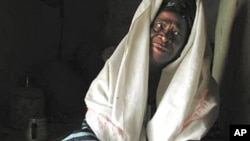A new U.N. Children's Fund study finds female genital mutilation remains widespread, but says attitudes are changing.
The UNICEF study says data from five African countries: Egypt, Ethiopia, Kenya, Senegal and Sudan - shows progress is being made in eliminating female genital mutilation, also known as cutting. This harmful practice is widely practiced throughout Egypt, Ethiopia and Sudan, but is performed only among certain population groups in Kenya and Senegal.
The study shows a significant change in attitude among women between the ages of 15 and 49. For example, the study says 60 percent of women in Ethiopia approved of Female Genital Mutilation in 2000. This figure declined by half five years later.
Significant drops in approval rates also are found in Egypt and Sudan. In Kenya and Senegal there is widespread disapproval of the practice.
But UNICEF spokeswoman Marixie Mercado says families are reluctant to abandon a practice they believe to be of benefit to their daughters.
"The main reason that parents have their daughters cut or mutilated is really to provide them with economic and social security in a sense," Mercado said. "It is to make sure that their daughters are accepted by society, that they can get married and have a chance of a normal life. In many of these cultures and traditions, not being 'cutted' is sanctioned."
Global estimates on how many girls and women have been subjected to female genital mutilation range from 70 million - 140 million. In Africa, an estimated three million girls and women are at risk every year.
The practice also is found in some countries in Asia and the Middle East, and to a lesser extent within some immigrant communities in Europe, Australia, Canada, New Zealand and the United States.
Mercado says earlier attempts to end female genital mutilation had limited impact because communities saw them as attacks against their traditions. According to Mercado, successful programs to end this practice must involve respected community members, including religious and local leaders.
She says the study shows communities where female genital mutilation is practiced are motivated by the desire to protect girls and make them eligible for marriage.
"Interestingly, this motivating factor of parents doing what is best for their daughters may also spur the decision to stop the practice, once social norms have evolved and social expectations have changed," Mercado noted. "Of course, religion, tradition and culture are also cited by families as reasons for cutting their daughters. And many communities, for example, believe that mutilation or cutting is mandated by religious doctrine, despite the fact that no major religion requires it."
The study finds laws against Female Genital Mutilation can be counterproductive in that they often drive the practice underground.
UNICEF Reports Progress in Eliminating Female Genital Mutilation





